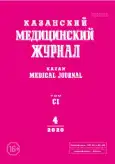The features of the intrafascicular structure of the thoracodorsal nerve trunk in terms of restoring afferent innervation in breast reconstruction
- Authors: Gorbunov NS1,2, Kober KV1, Kasparov EV2, Protasyuk EN1
-
Affiliations:
- Krasnoyarsk State Medical University named after V.F. Voino-Yasenecky
- Research Institute for Medical Problems in the North
- Issue: Vol 101, No 4 (2020)
- Pages: 519-523
- Section: Theoretical and clinical medicine
- URL: https://journal-vniispk.ru/kazanmedj/article/view/33881
- DOI: https://doi.org/10.17816/KMJ2020-519
- ID: 33881
Cite item
Abstract
Aim. To study of anatomical and topographic features and the intrafascicular structure of the thoracodorsal nerve trunk in the brachial plexus.
Methods. The study was performed on the brachial plexus preparations of 80 male and female corpses. Short and long branches, secondary bundles, primary trunks, spinal nerves, anterior and posterior roots of the spinal cord were layer-by-layer anatomically prepared from brachial plexus. The angles of inclination from the arising site of the thoracodorsal nerve, the topography throughout and after entering the latissimus dorsi muscle were studied. The length and thickness of the thoracodorsal nerve, including the extramuscular and intramuscular parts, were measured. After isolation and fixation of the preparations, intrafascicular dissection of the thoracodorsal nerve was performed throughout the brachial plexus, by using microsurgical instruments and a binocular magnifier.
Results. The length of the thoracodorsal nerve consists of extramuscular and intramuscular parts and was equal to 17.9 cm, of which the extra-muscular part was three-quarters of the total length of the nerve. The nerve trunk dissection revealed that the thoracodorsal nerve consists of 1–4 nerve fascicles and most frequently, in 46.2% of preparations, the thoracodorsal nerve arises from the C7 nerve root. The presence of motor and sensory portions of nerve fibers in the thoracodorsal nerve was found. In 90.2% of the preparations, the motor portion was located in the posterior-lateral part of the nerve and sensory in the anterior-medial. In most cases, both the sensory and motor fascicles arose from C7, or motor fascicle from C7 and sensory from C8.
Conclusion. The intrafascicular dissection of the thoracodorsal nerve revealed microtopography of the sensitive and motor portions of nerve fibers in the nerve and along the entire length of the brachial plexus; in breast reconstruction, after mastectomy with thoracodorsal flap for the preservation of afferent innervation, it is recommended to cross only motor fibers of the thoracodorsal nerve.
Full Text
##article.viewOnOriginalSite##About the authors
N S Gorbunov
Krasnoyarsk State Medical University named after V.F. Voino-Yasenecky; Research Institute for Medical Problems in the North
Email: gorbunov_ns@mail.ru
ORCID iD: 0000-0003-4809-4491
ResearcherId: W-4527-2017
Russian Federation, Krasnoyarsk, Russia; Krasnoyarsk, Russia
K V Kober
Krasnoyarsk State Medical University named after V.F. Voino-Yasenecky
Author for correspondence.
Email: k-kober@mail.ru
ORCID iD: 0000-0001-5209-182X
ResearcherId: D-9666-2019
Russian Federation, Krasnoyarsk, Russia
E V Kasparov
Research Institute for Medical Problems in the North
Email: rsimpn@scn.ru
Russian Federation, Krasnoyarsk, Russia
E N Protasyuk
Krasnoyarsk State Medical University named after V.F. Voino-Yasenecky
Email: demonschire@mail.ru
ORCID iD: 0000-0002-1204-7821
Russian Federation, Krasnoyarsk, Russia
References
- Champaneria M.C., Wong W.W., Hill M.E., Gupta S.C. The evolution of breast reconstruction: a historical perspective. World J. Surg. 2012; 36 (4): 730–742. doi: 10.1007/s00268-012-1450-2.
- Beugels J., Cornelissen A.J.M., Spiegel A.J. et al. Sensory recovery of the breast after innervated and non-innervated autologous breast reconstructions: A systematic review. J. Plast. Reconstr. Aesthet. Surg. 2017; 70 (9): 1229–1241. doi: 10.1016/j.bjps.2017.05.001.
- Kober K.V., Gorbunov N.S., Sindeeva L.V., Сhikun V.I. Macro-anatomic and intrainal structure of the thoracodorsal nerve. Modern problems of science and education. 2019; (3): 133. (In Russ.)
- Fracol M., Grim M., Lanier S.T., Fine N.A. Vertical skin paddle orientation for the latissimus dorsi flap in breast reconstruction. Plast. Reconstr. Surg. 2018; 141 (3): 598–601. doi: 10.1097/prs.0000000000004103.
- Potter S.M., Ferris S.I. Vascularized thoracodorsal to suprascapular nerve transfer, a novel technique to restore shoulder function in partial brachial plexopathy. J. Front. Surg. 2016; 3: 17. doi: 10.3389/fsurg.2016.00017.
- Zin T., Maw M., Oo S. et al. How I do it: Simple and effortless approach to identify thoracodorsal nerve on axillary clearance procedure. Ecancer Med. Sci. 2012; 6: 255. doi: 10.3332/ecancer.2012.255.
- Paolini G., Longo B., Laporta R. et al. Permanent latissimus dorsi muscle denervation in breast reconstruction. Ann. Plastic Surg. 2013; 71 (6): 639–642. doi: 10.1097/sap.0b013e31825c0840.
- Hwang M.J., Sterne G. Thoracodorsal nerve division in latissimus dorsi breast reconstruction to avoid unwanted breast animation: a safe and simple technique to ensure division of all branches. J. Plast. Reconstr. Aesthet. Surg. 2015; 68 (2): e43–e44. doi: 10.1016/j.bjps.2014.09.051.
- Baitinger V.F., Silkina K.A. Sensitive innervation of microsurgical flaps which are used in reconstructive mammoplasty. Voprosy rekonstruktivnoy i plasticheskoy khirurgii. 2014; (2): 11–19. (In Russ.)
- Sood R., Easow J.M., Konopka G., Panthaki Z.J. Latissimus dorsi flap in breast reconstruction: recent innovations in the workhorse flap. Cancer Control. 2018; 25 (1): 1–7. doi: 10.1177/1073274817744638.
Supplementary files








